Edogawa Craft Stories

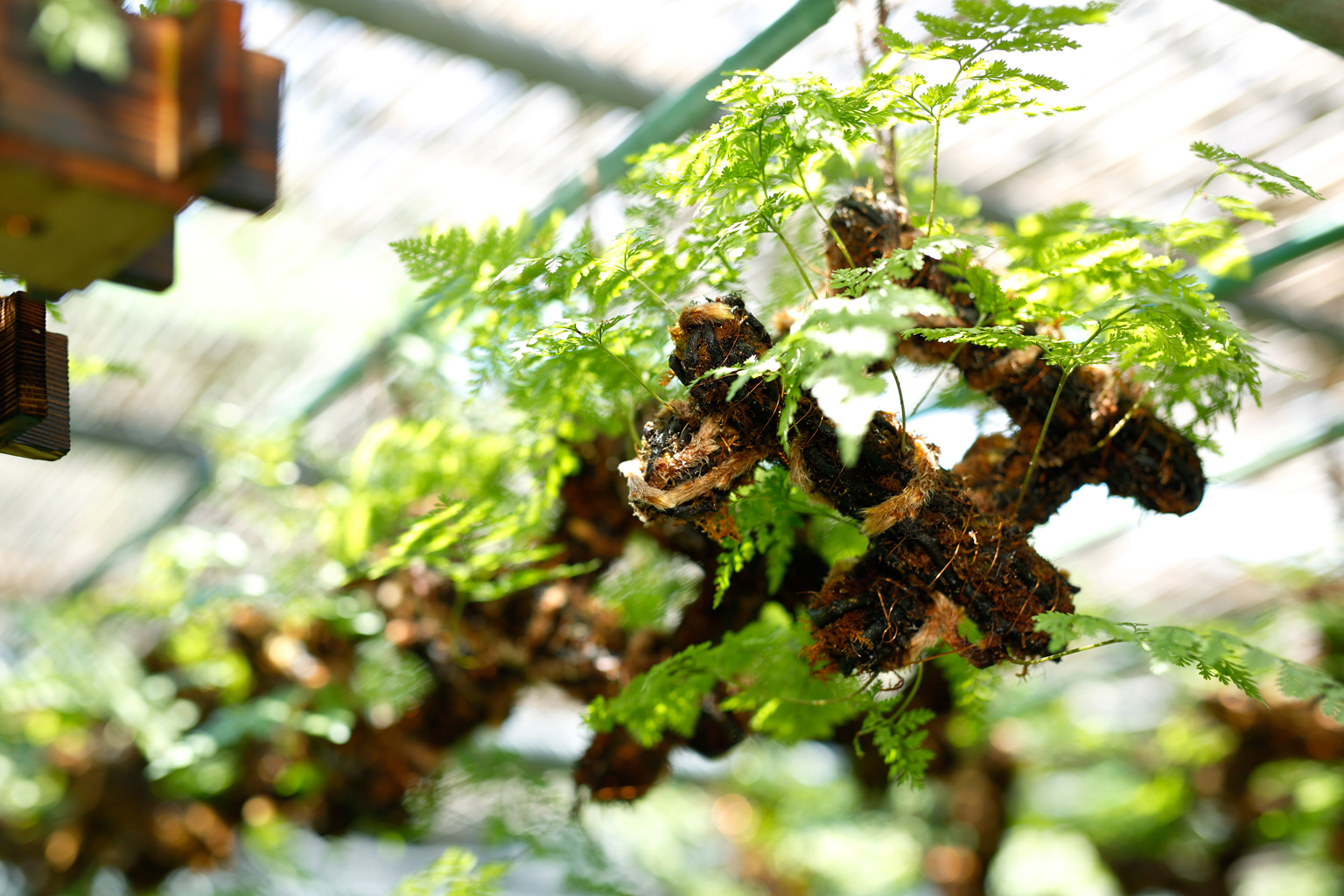
Tsurishinobu: Hanging Greenery That Brings Summer Coolness — A Seasonal Edo Tradition Living On Today
Tsurishinobu
Yorozuen
Fukano Eiko
The delicate fronds of the shinobu plant sway gently in the breeze. Tsurishinobu is a traditional ornamental plant and craft, hung from eaves during the peak of summer to offer a cooling visual charm—a practice that dates back to the Edo period. Today, the only dedicated producer of tsurishinobu in Tokyo is Yorozuen, located in Matsushima, Edogawa City. Fukano Eiko, who has run the family business for 90 years since its founding in 1935, continues to bring a touch of cool elegance to the city’s summers by combining the blessings of nature with skilled craftsmanship.
The Charm of Tsurishinobu, from Eaves to Interior
Tsurishinobu is made by carefully arranging the thick rhizomes of the shinobu fern — a type of fern that grows by clinging to rocks or trees — onto a moss-covered base, shaping it into various forms to be hung and enjoyed as a decorative plant. It is said to have originated in the Edo period, created by gardeners as mid-summer gifts for their clients. Even today, it remains a beloved seasonal tradition that evokes coolness in the heat of summer.
The only specialist still preserving this craft in Tokyo is Yorozuen’s Fukano Eiko.
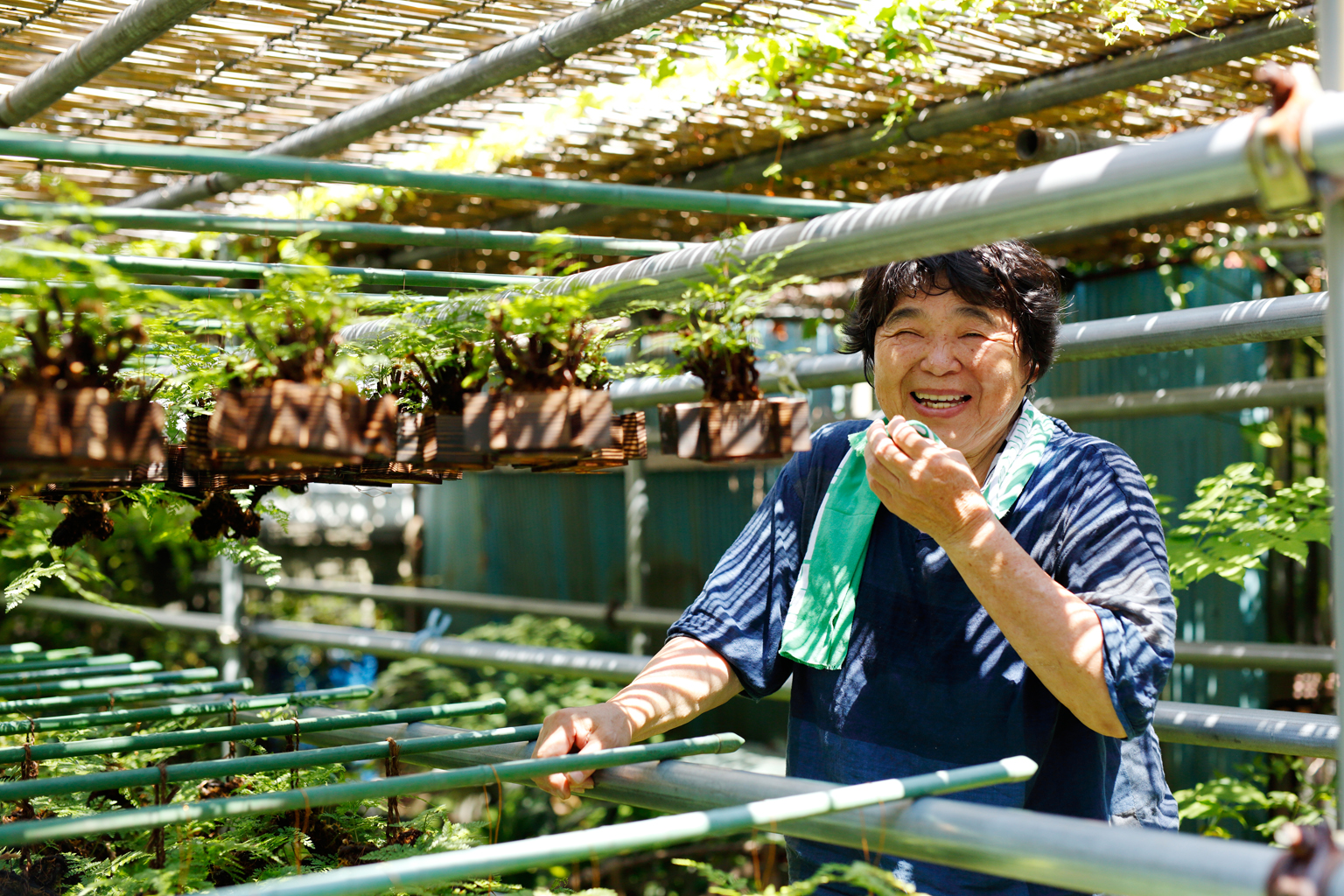
Fukano was born in Nagareyama City, Chiba Prefecture. After marrying into the Yorozuen family, she learned the craft by observing her father-in-law, the founder. Alongside her late husband Terumasa, the second-generation head, she supported production for over 50 years.
“People often associate tsurishinobu with a refreshing look in summer, but the leaves turn beautiful shades in autumn too. Even after the leaves fall in winter, with proper care, the plant can be enjoyed for decades. Some customers even have pieces that have been passed down from their parents — over 30 years old.”
Unlike ferns that root directly into the ground, shinobu grows by spreading its hairy rhizomes and clinging to surfaces. As long as it’s kept out of direct sunlight and watered appropriately, new shoots will continue to emerge and grow from the parent rhizome.
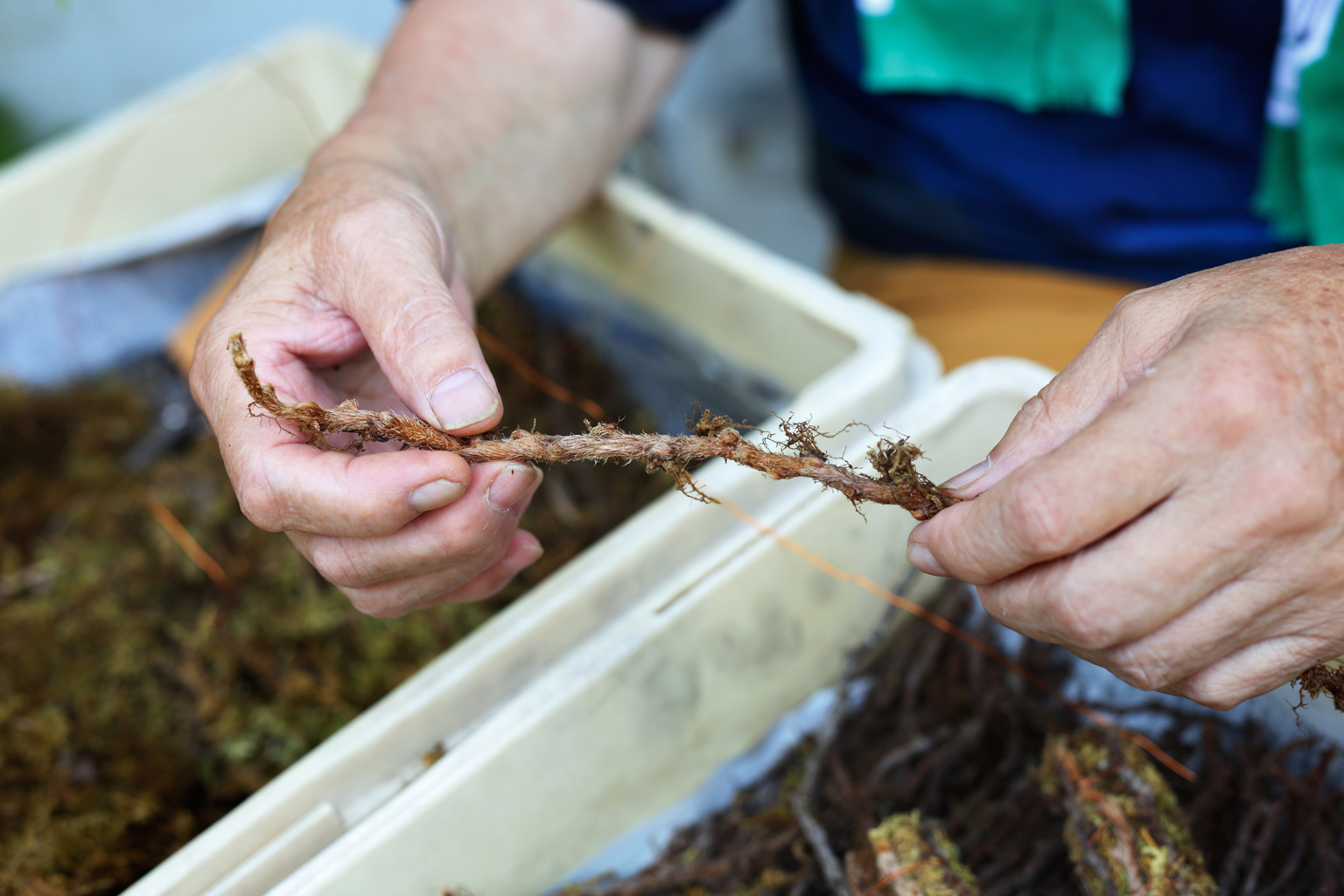
The rhizome of the shinobu fern used in tsurishinobu. Its name comes from its ability to tae-shinobu (“endure”) both dryness and cold.
Yorozuen produces around ten different styles of tsurishinobu, including traditional designs such as the igeta—built with wood arranged in a well frame pattern—and the ikada, inspired by a river raft. Some styles lean more traditional, while others offer a modern twist that fits contemporary interiors.
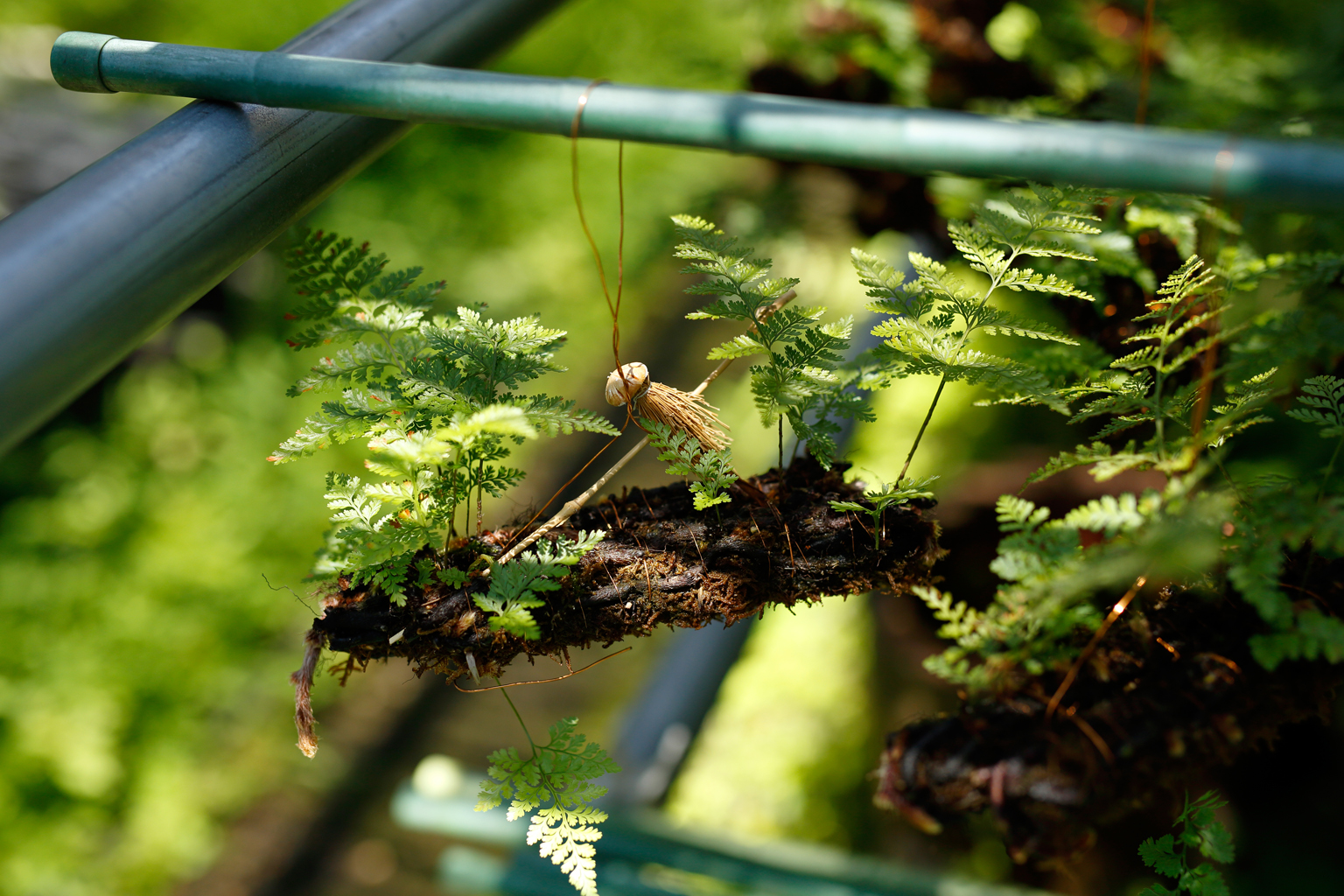
The ikada style features a tiny bamboo boatman riding the raft.
“A young woman I spoke with recently said she enjoys hanging hers in the bathroom. One of our most popular items is the Ido (Well), where the shinobu is placed within a wooden base assembled in the igeta pattern. It can be hung or placed on a tabletop. My son Hiromasa handles the shaving of the wood to bring out the grain and assembles the base. These days, fewer homes have eaves, so more people are displaying them indoors.”
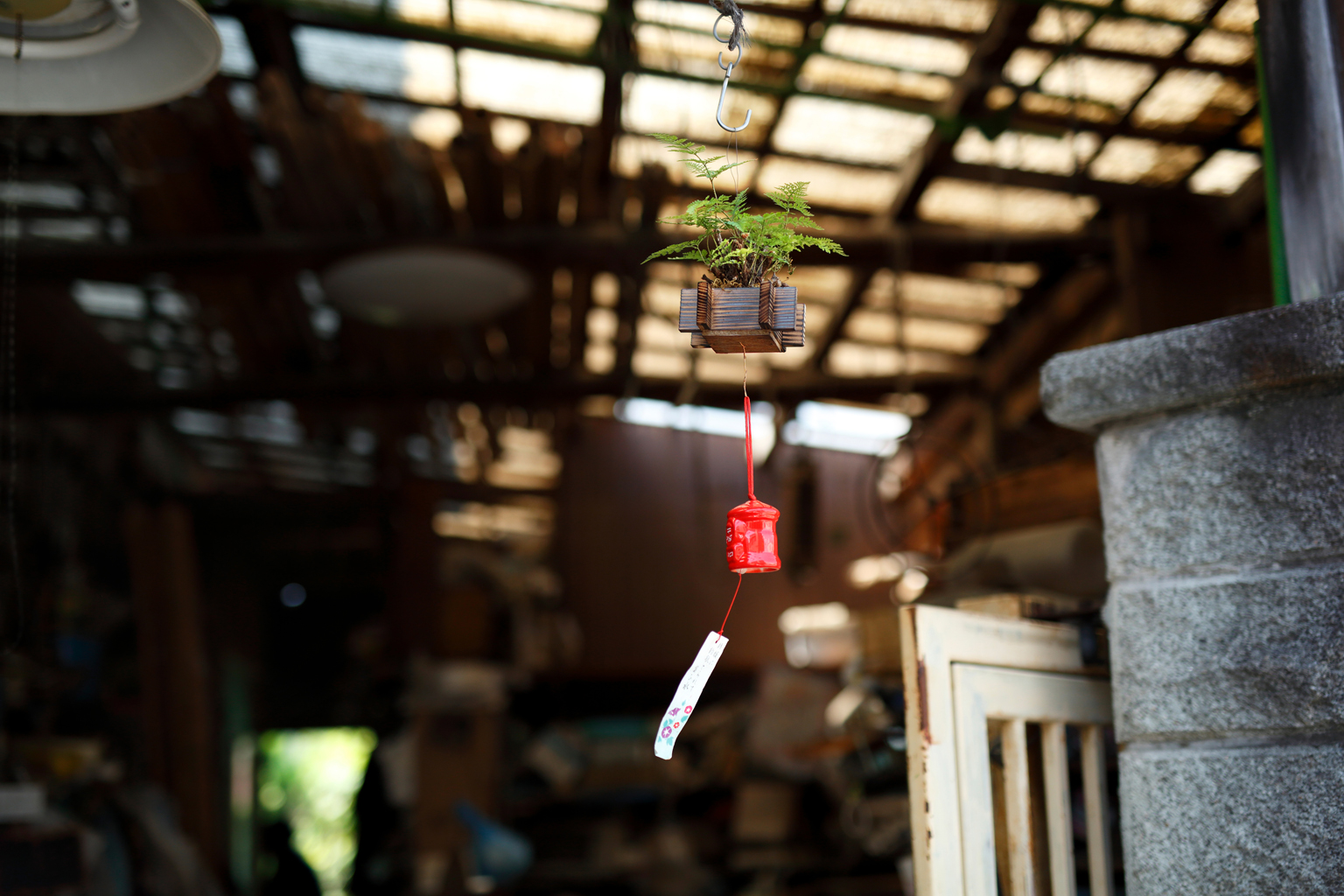
An Ido tsurishinobu at the entrance to the workshop. It sits on a wooden base and can also be hung. A charming wind chime shaped like a postbox gently sways from the hook beneath.
Preparing in Winter for Summer Shipment: The Handmade Process Behind Each Piece
While the peak shipping season for tsurishinobu is from June to August, preparations begin the previous winter. In November, wild shinobu ferns gathered from remote mountain areas are delivered by foragers. Fukano Eiko carefully cleans and sorts them while also sourcing haigoke (fern moss), which she uses to form the base. Once the materials are ready, production begins in spring. The tsurishinobu are typically ready to ship by mid-May each year.
In the workshop, Fukano demonstrated how she makes the igeta style. She starts by wrapping soft, fluffy haigoke around a bamboo core. This moss serves as a substitute for soil, storing moisture and allowing the shinobu rhizomes to take hold easily.
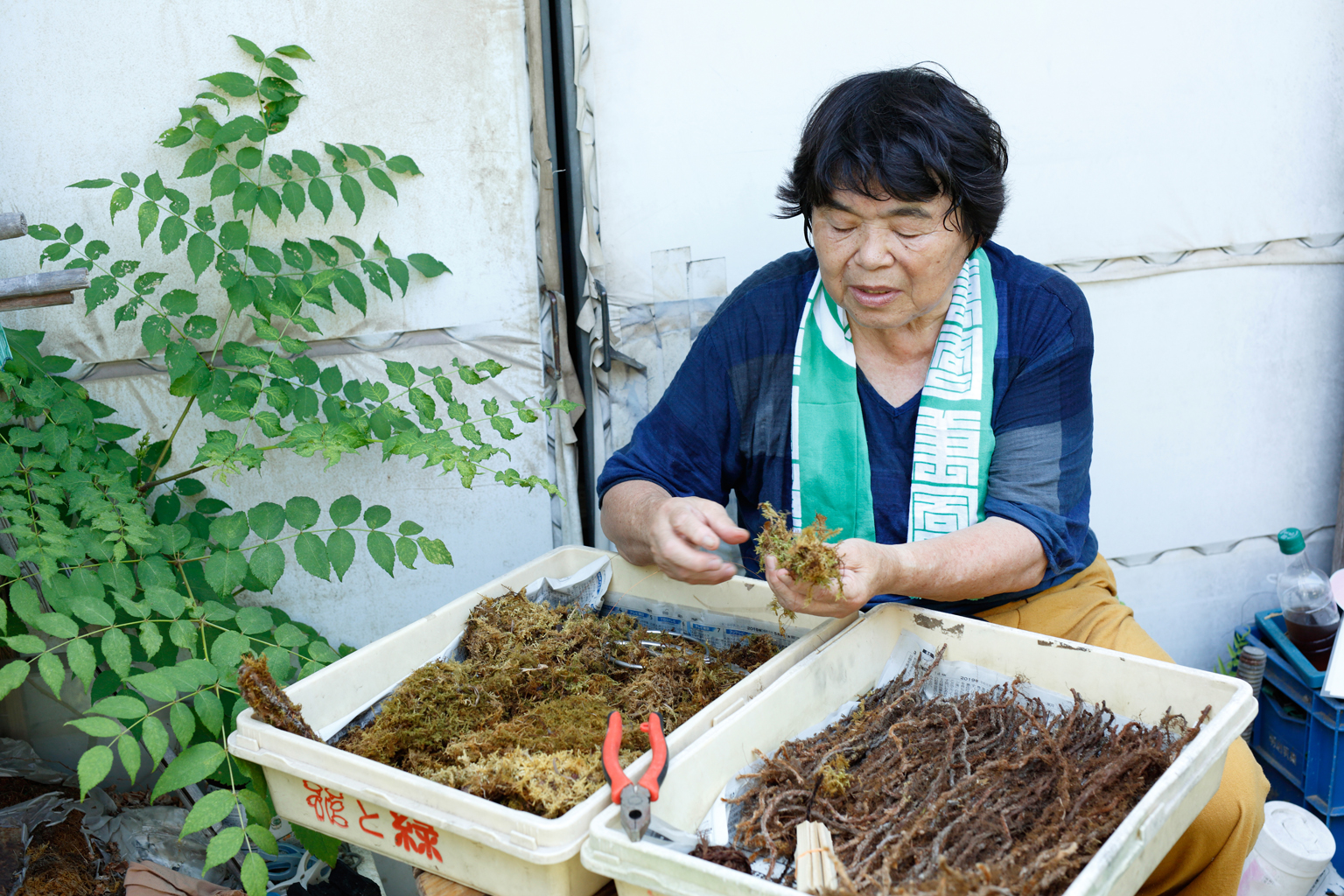
Haigoke moss in Fukano’s hands. Known for thriving in various environments from rocky outcrops to wetlands, it’s commonly used in moss gardens and bonsai due to its ease of propagation and strong rooting ability.
Once the moss has been wrapped around the base, she attaches the shinobu. The process involves checking the direction of the rhizomes and ensuring their roots press firmly into the moss.
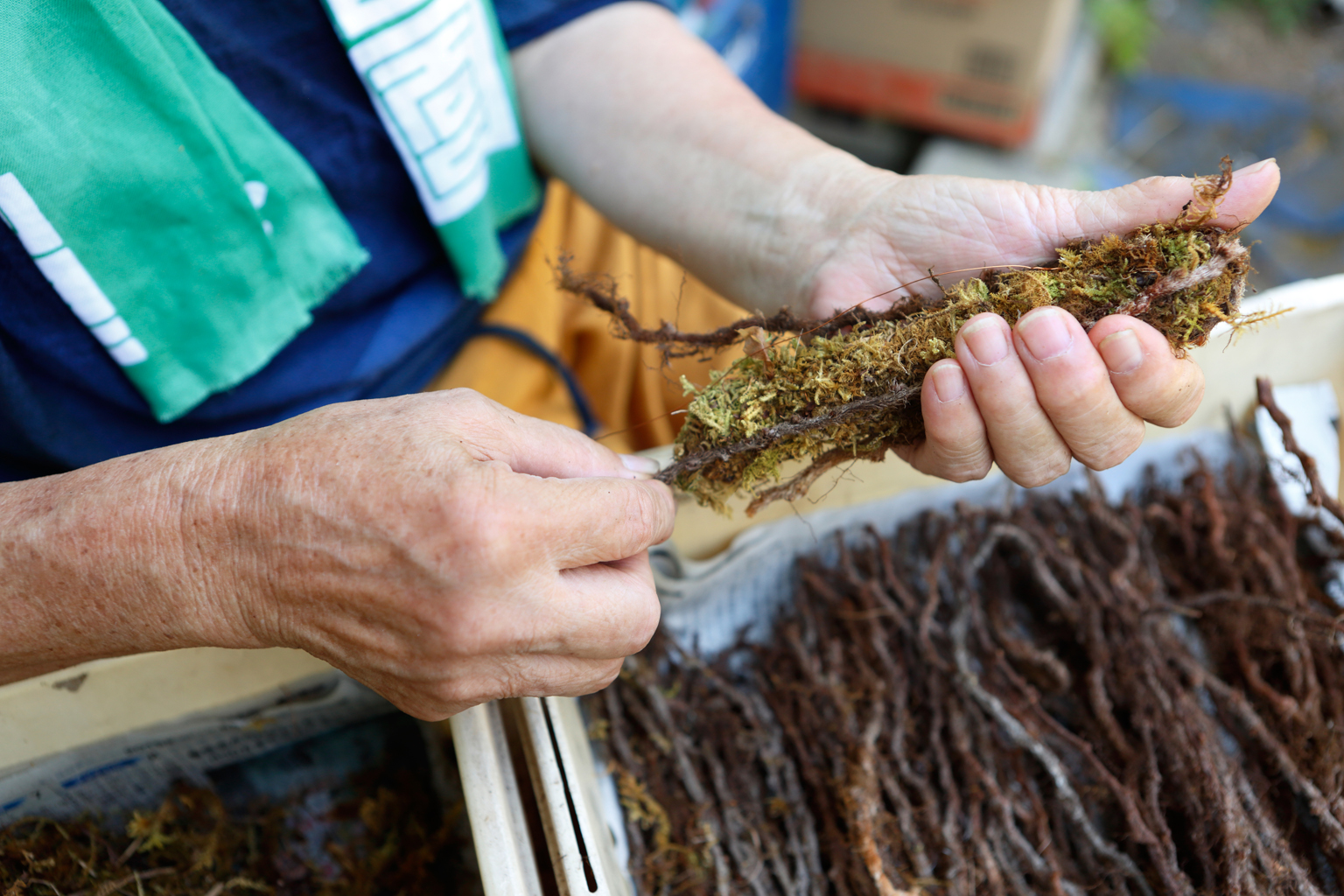
The rhizomes are fixed to the moss-covered base in a cross shape using copper wire, with care taken to orient the roots toward the moss and the buds outward.
“I want the leaves to grow in just the right spots once it’s hanging, so I check the position of the buds and secure them with copper wire. But in the end, you won’t know how the leaves will sprout until they grow — that’s just how it is with living things.”
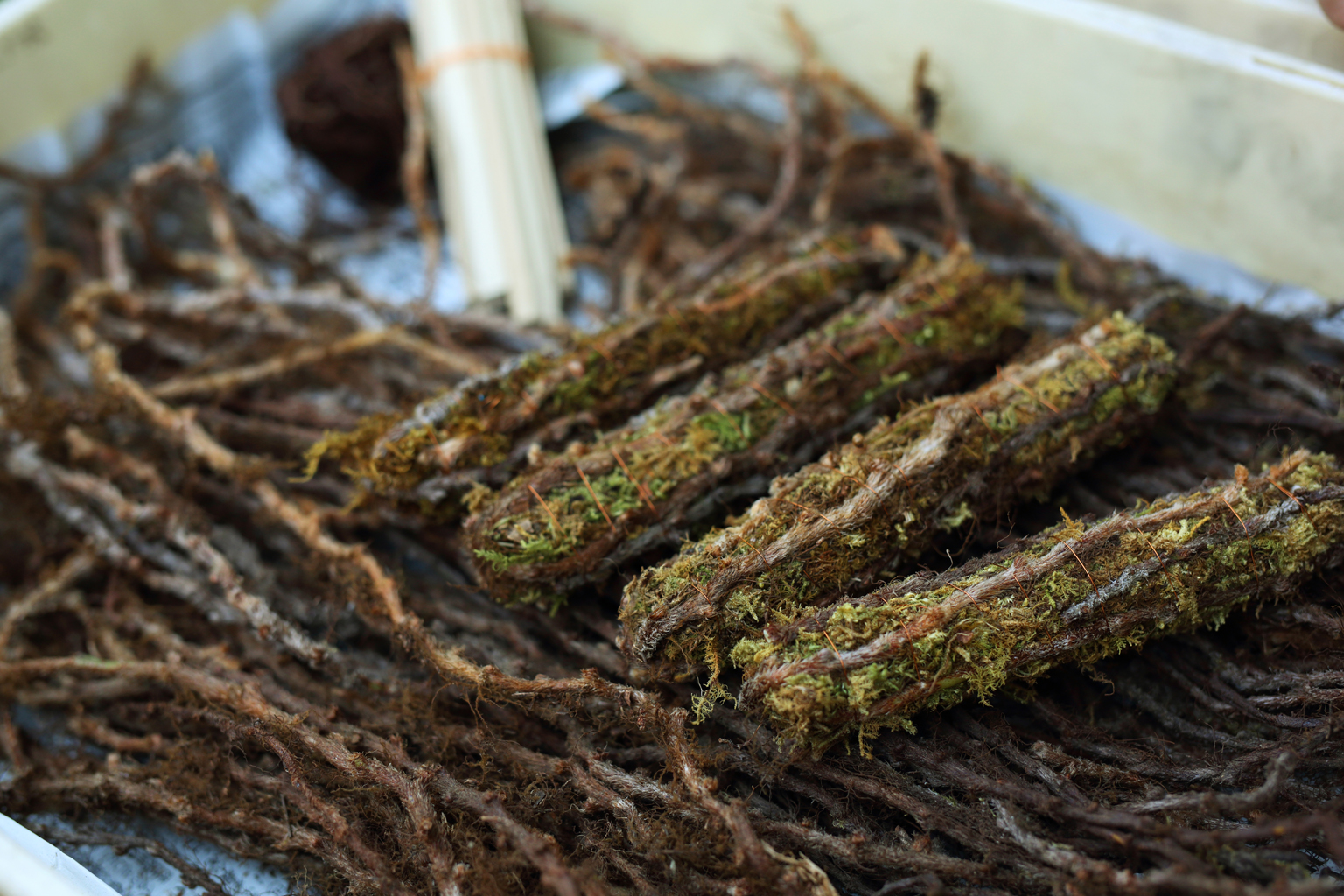
The fuzzy, gray thread-like rhizomes of the shinobu are visible on the moss-covered base.
Finally, four moss-wrapped bases with attached shinobu are fastened together in the igeta shape using copper wire. A cord is then added for hanging, and the piece is complete in form. Over the next few months, with regular watering and moderate sunlight, the leaves grow in preparation for shipment.
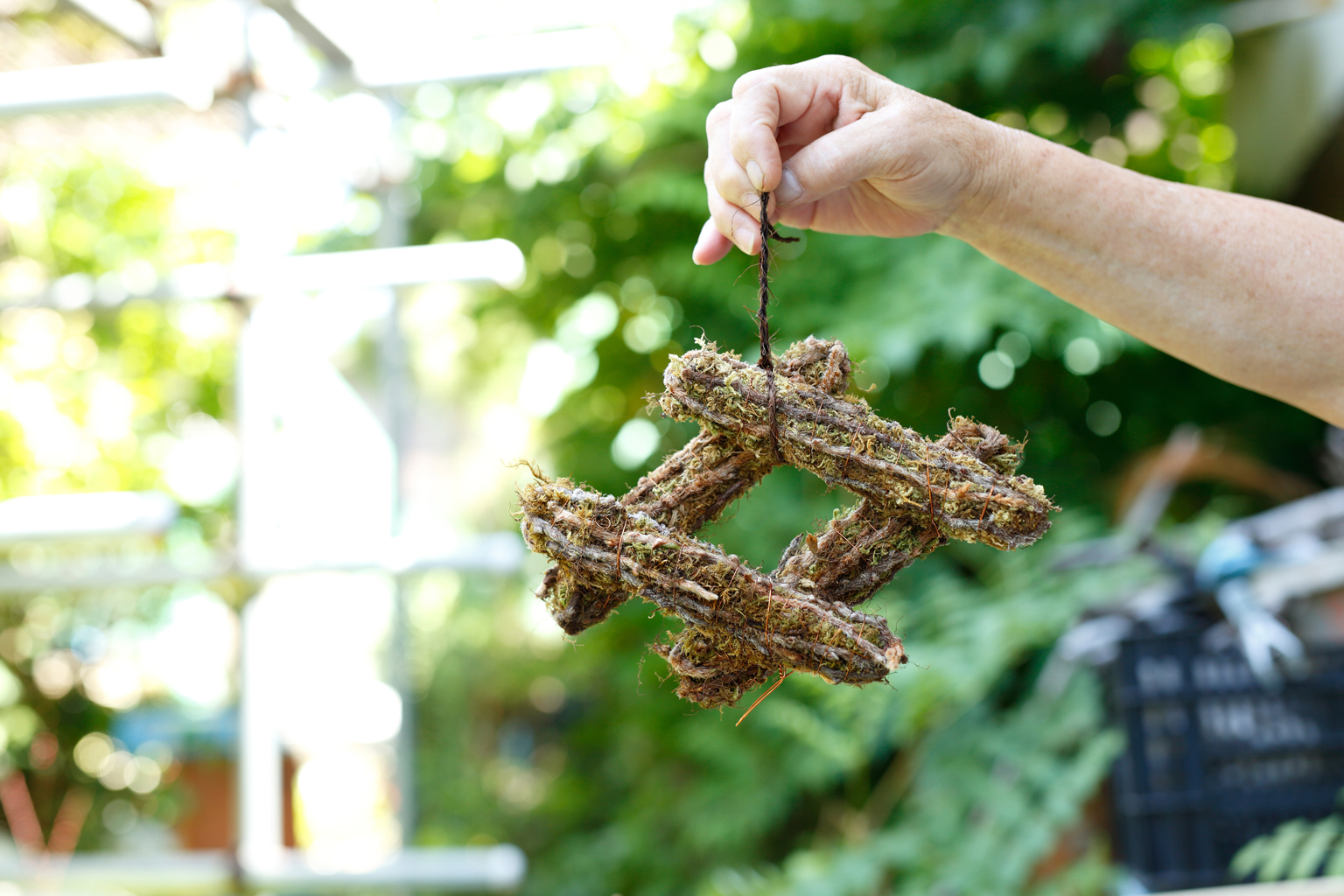
The completed igeta form, ready for several months of care before the shinobu’s lush leaves emerge.
Yorozuen also occasionally hosts hands-on workshops for children. For many kids, working directly with plants is a novel experience, and Fukano says she often sees their nervous expressions transform into enthusiasm.
“At first, they’re unsure how to hold the rhizomes and approach the task very cautiously. Some even bring gloves because they’re hesitant to touch the moss with bare hands. But once they get into it, they take off the gloves and eagerly attach the shinobu. It’s so sweet to see. And when I get follow-up messages saying ‘It sprouted!’ it really makes me happy.”
90 Years of History, Sustained by Bonds with Customers
Yorozuen was founded in 1935 (Showa 10). Fukano’s father-in-law, the founder, was known for his sharp business instincts.
“In the early days, he sold not only tsurishinobu but also flowers and bonsai. If a few rows of flowers weren’t selling, he would quickly clear them away. That way, when the next customers came, they’d think ‘These must be popular!’ and buy them. It was quite the bold approach!”
Back in the 1950s and 60s, during Japan’s rapid economic growth, there were around 20 tsurishinobu producers in Edogawa City. In 1969 (Showa 44), Fukano married into the family, leaving behind her career as a hairdresser. From that point on, Yorozuen shifted focus to become a dedicated tsurishinobu producer. With her father-in-law and husband Terumasa—the second-generation head—the trio entered their heyday, producing over 3,000 pieces annually.
“Before married into the family, I was told I wouldn’t need to help, but they were so busy I had no choice! My father-in-law was an old-school craftsman; he never explained how to make anything. I had to watch his hands carefully and learn by imitation.”
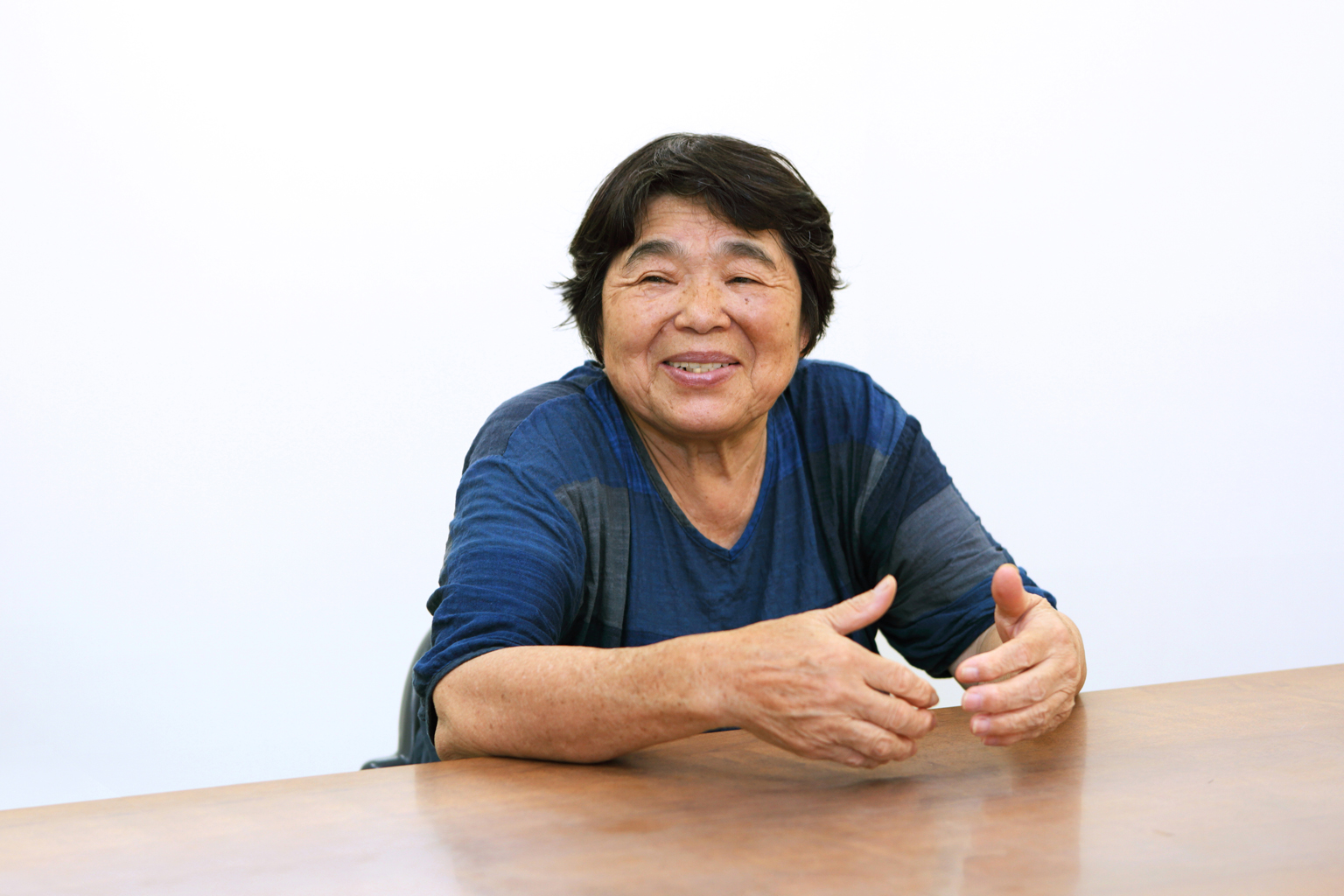
Fukano reflects on her early days after marrying into the Yorozuen family.
After the passing of her father-in-law, Fukano’s husband Terumasa took over as the second-generation head. A highly skilled artisan, he was recognized as an Intangible Cultural Property by Edogawa City and awarded the Tokyo Governor’s Award for Outstanding Skilled Workers (Tokyo Meister Award). However, in April 2023, just after preparing for summer shipments, he passed away suddenly at the age of 81. Fukano now continues the craft alongside her son Hiromasa, with whom she has honed her skills for over 50 years.
Today, Yorozuen is the only business in Tokyo that specializes exclusively in tsurishinobu, and production has dropped to around 200 pieces per year. What continues to support Fukano through these changes are the relationships she’s built with customers who love the craft. One restaurant in Tokyo, for instance, has been decorating its interior with tsurishinobu from Yorozuen for over 30 years.
“They’ve even created dedicated display spots inside and outside the restaurant just for tsurishinobu. It really encourages me to know that people look forward to them that much.”
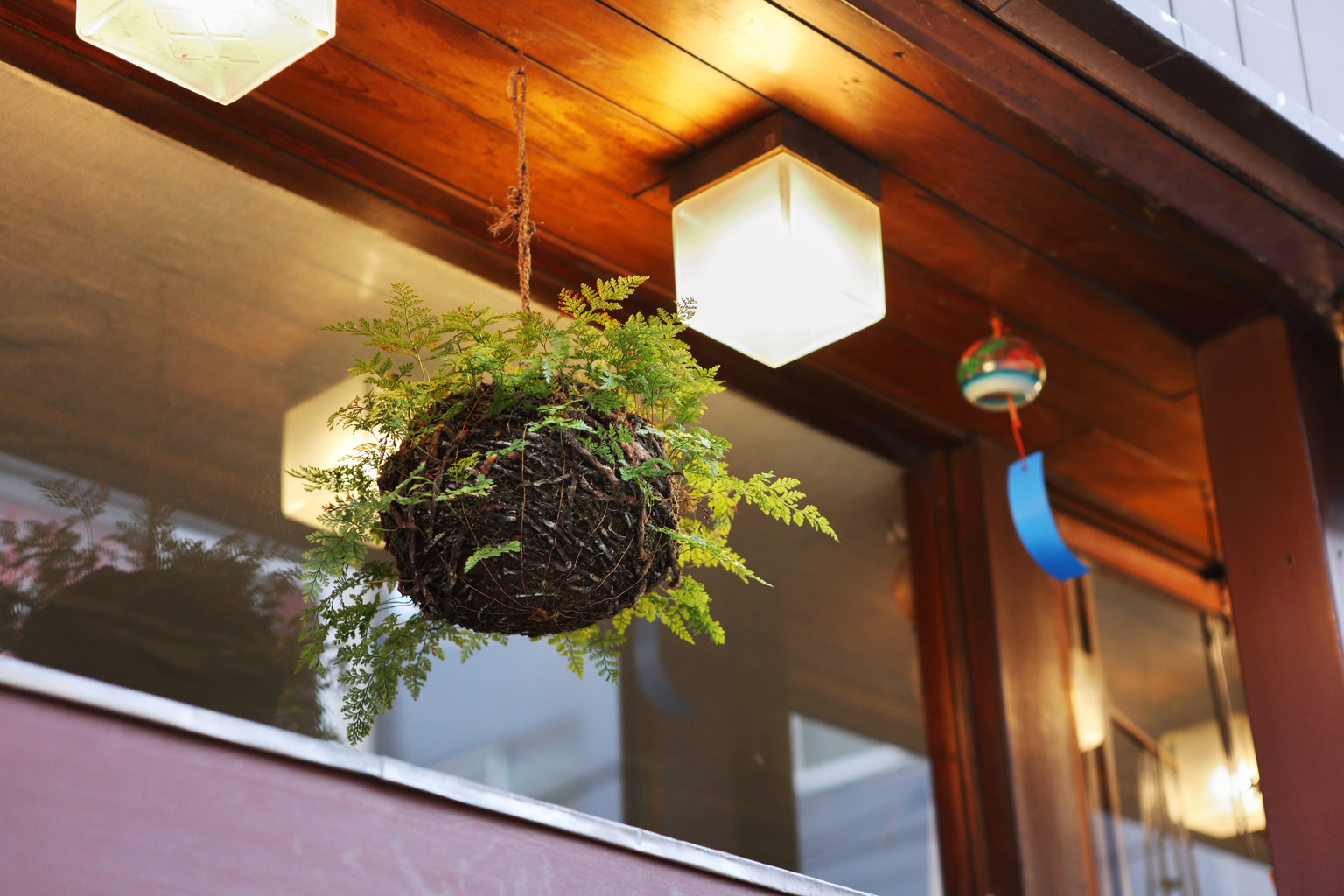
Sakamoto Soba, a restaurant on the Soshigaya-Okura shopping street of in Setagaya City. Captivated by the gentle swaying of shinobu leaves in the breeze, they’ve been adorning their shop with tsurishinobu from Yorozuen for over 30 years.
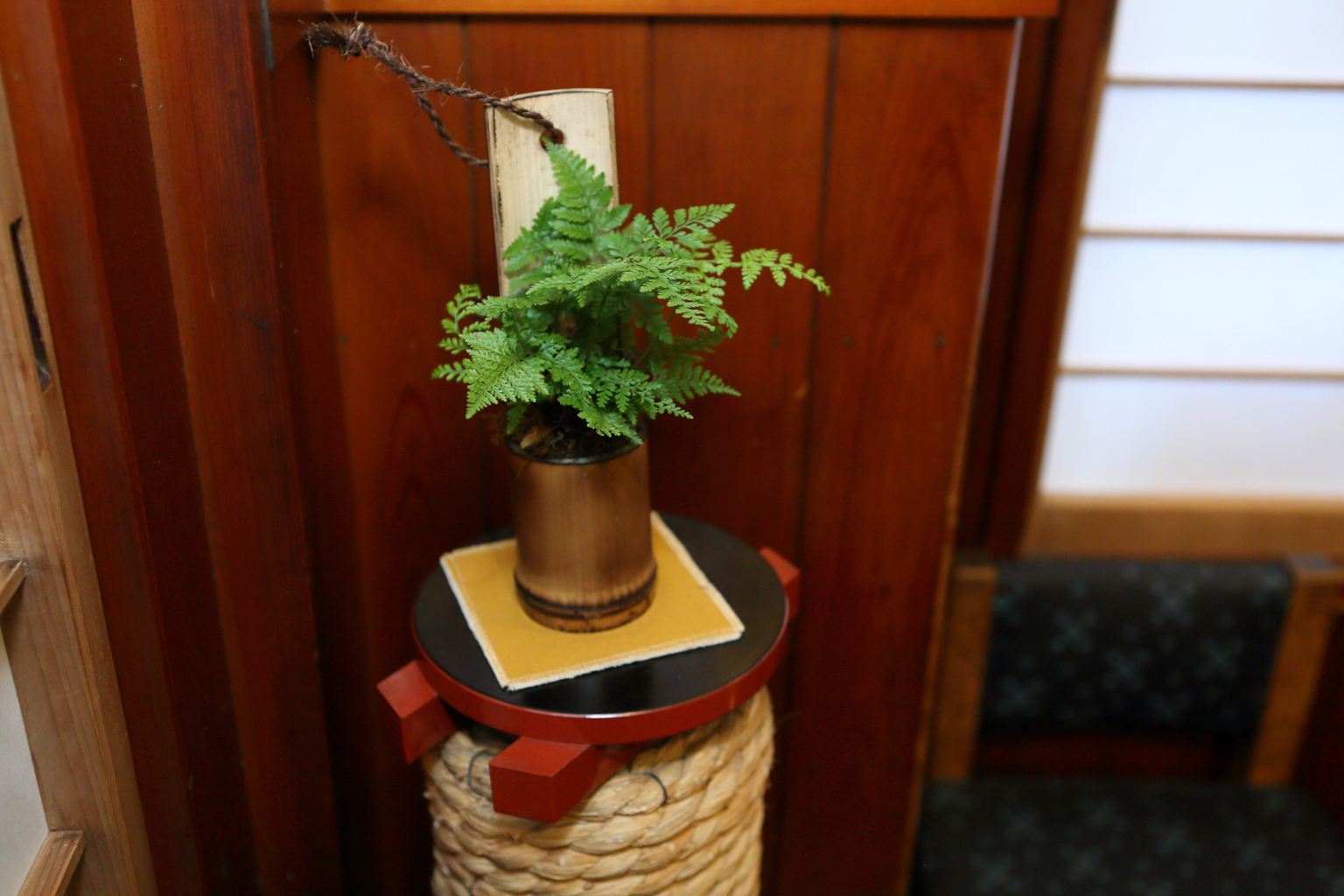
Inside Sakamoto Soba. Alongside the tsurishinobu, you’ll also find wind chimes and goldfish bowls—thoughtful touches that continue the Edo-period tradition of enjoying coolness during summer.
Grateful for Nature’s Gifts, Committed to Passing on the Craft
The greatest challenge for the future of tsurishinobu production lies in sourcing the raw material—the shinobu fern. Once gathered in nearby areas around the Kanto region, it’s now only obtainable from more distant locations. Behind this shift are environmental changes in the mountains and the declining number of skilled foragers who know the terrain.
“Shinobu grows in very specific environments like rocky outcrops deep in the mountains, so collecting it is closer to mountain climbing than hiking. Even if I wanted to go myself, it’s hard to find unless you really know the mountains. People who regularly forage for mushrooms often say, ‘I wouldn’t know where to look for shinobu.’”
As fewer people venture into the mountains, more areas are becoming overgrown with thickets and bamboo, making them harder to access. Fukano shared that even long-time foragers have told her they were ready to stop collecting shinobu due to the difficulty.
“That happened the same year my husband passed away. But around that time, several newspapers happened to run stories introducing Yorozuen, so I sent those articles to the forager along with a request. They replied, ‘If it’s that important to you, I’ll keep doing it.’ If we hadn’t been able to get more shinobu, we would’ve had to stop altogether. I’m so grateful to them.”
Fukano and her family’s tireless efforts have kept tsurishinobu production alive, efforts that Edogawa City also supports. For nearly 20 years, Yorozuen participated in the Edogawa Traditional Craft Industry, Academia, and Public Project, a city-led initiative that brings traditional craftspeople together with art university students to create new forms of traditional craft. One example is Goldfish and Shinobu, a piece designed a few years ago by Iwaki Miki from Tama Art University, which wraps a goldfish bowl in tsurishinobu and remains a popular product to this day.
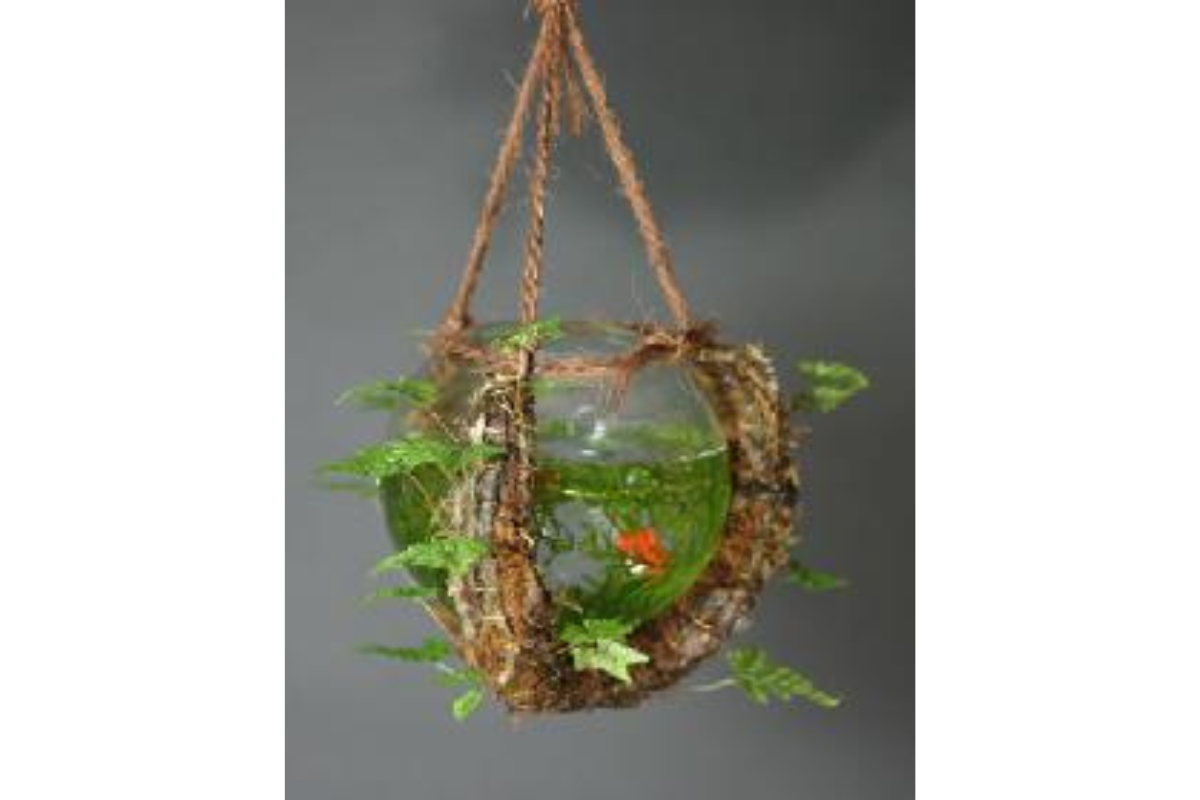
Goldfish and Shinobu, a piece that wraps a goldfish bowl in shinobu. It’s now one of Yorozuen’s best-loved items.
Even while facing the uncertainty of raw material supply, Fukano remains optimistic.
“Because we’re working with nature, I honestly don’t know whether we’ll be able to keep sourcing shinobu in the future. But as long as I can get it, I’ll keep making these. It’s another hot summer, and if someone can feel just a little cooler looking at a tsurishinobu, that would make me happy.”
Founded 90 years ago, Yorozuen continues to combine the blessings of nature with human craftsmanship, bringing the beauty of traditional summertime cool into the modern day. Fukano’s work carries on—together with gratitude for all those who cherish the craft.
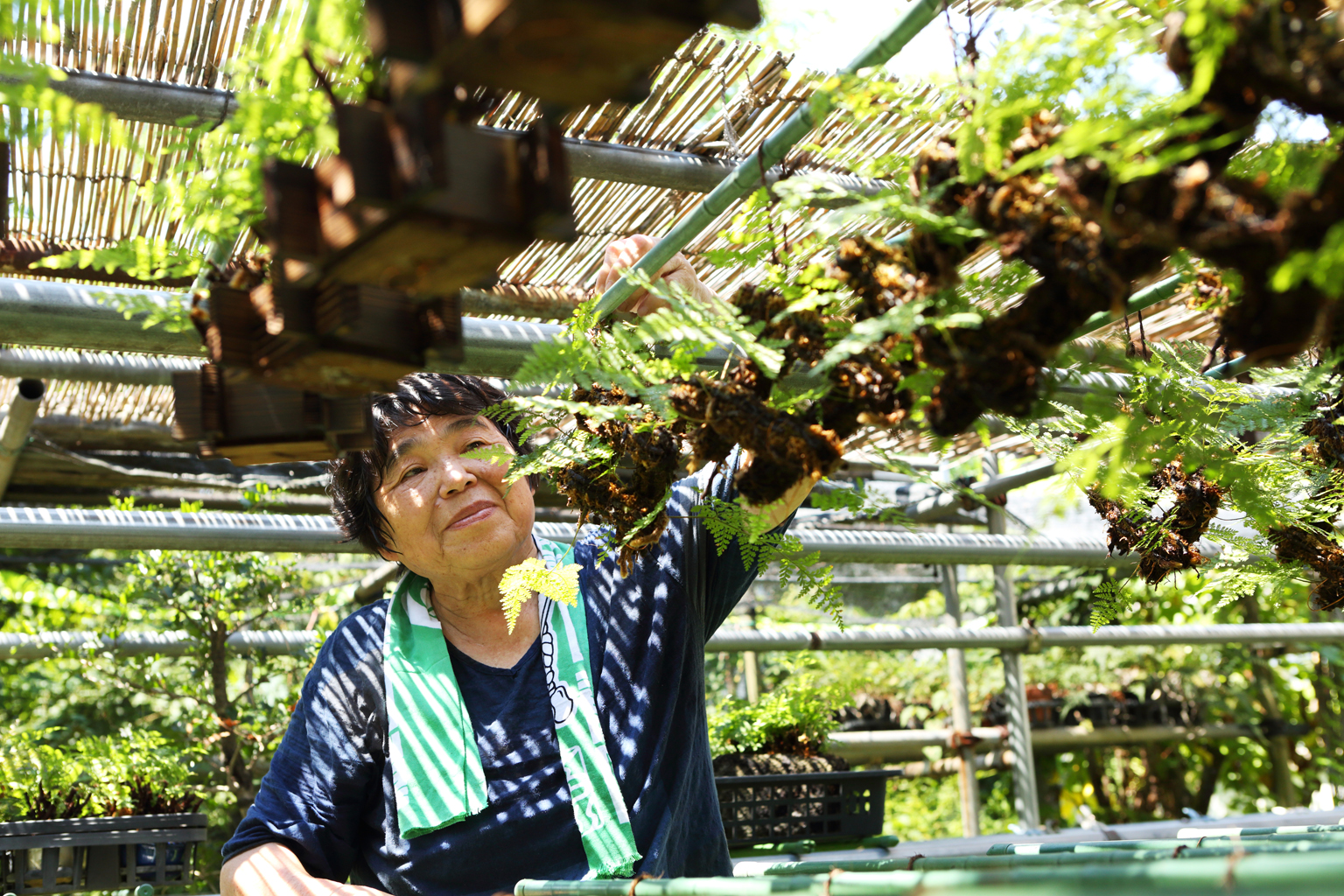
Writing: Kiuchi Aki
Photos: Takeuchi Akiko
Introduction of the Artisan
Yorozuen was founded in 1935 as a wholesaler of flowers and bonsai. In the 1960s and 70s, it shifted to specialize exclusively in tsurishinobu. While preserving traditional techniques dating back to the Edo period, the second-generation artisan Terumasa Fukano (recipient of the Edogawa City Intangible Cultural Property designation and the Tokyo Governor’s Award for Outstanding Skilled Workers) and his wife Eiko led efforts to develop designs suited to modern living spaces. Following Terumasa’s passing in 2023, the craft is now carried on by Eiko and their son Hiromasa, who continue to bring a sense of cool to hot summer days.
・Yorozuen
・1-32-11 Matsushima, Edogawa-ku, Tokyo

